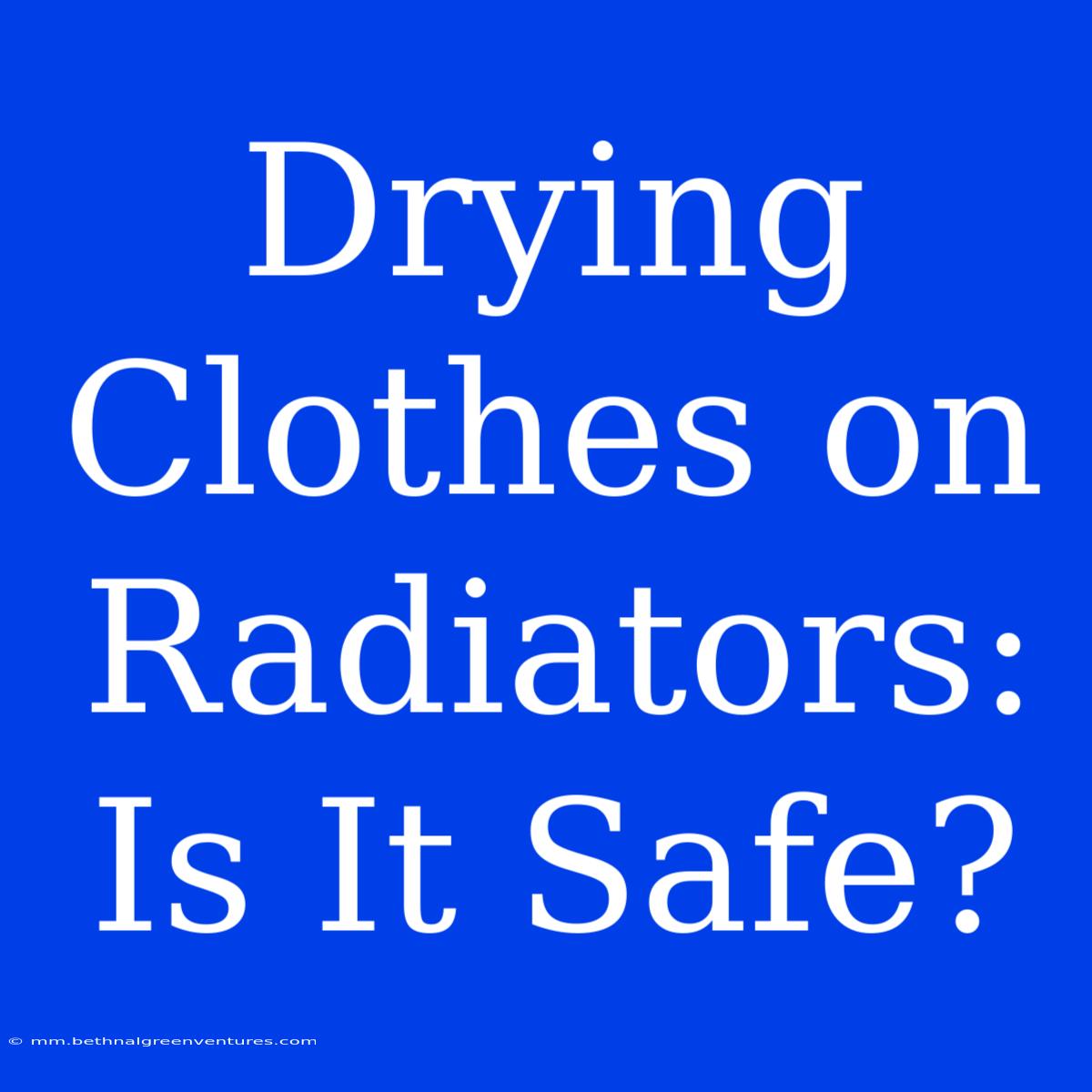Drying Clothes on Radiators: Is It Safe? A Comprehensive Guide
Are you wondering if drying clothes on radiators is safe? Drying clothes on radiators is a common practice, but it can pose some risks. This guide will explore the potential safety concerns and offer insights into safer alternatives.
Editor Note: This article explores the safety of drying clothes on radiators, a practice many find convenient, but with potential risks. Understanding the pros and cons of this method is crucial for making informed choices.
Why is this topic important? Drying clothes on radiators is a convenient and energy-efficient method, but it can lead to safety hazards, such as fire risks, damage to clothing, and health issues. This article aims to provide a comprehensive overview, including the risks, alternatives, and best practices, helping readers make informed decisions regarding their clothes drying habits.
Analysis: We thoroughly researched existing safety regulations, expert opinions, and case studies related to radiator drying, analyzing the potential risks and benefits. We present the information in an easy-to-understand format, enabling readers to assess the safety of radiator drying and discover alternatives.
Key Takeaways:
| Aspect | Description |
|---|---|
| Safety Concerns | Includes fire risks, damage to clothing, and potential health issues. |
| Alternatives | Explores safer methods like air drying, clotheslines, and electric dryers. |
| Best Practices | Provides practical tips for minimizing risks when drying clothes on radiators. |
Drying Clothes on Radiators
Safety Concerns
Introduction: Drying clothes on radiators, while seemingly convenient, can lead to several safety concerns that should be considered.
Facets:
- Fire Risk: The primary concern is the risk of fire. Wet clothing can be a fire hazard, especially when placed directly on a hot radiator. The fabric's moisture can absorb heat and potentially ignite if the radiator becomes too hot.
- Damage to Clothing: Overheating can lead to fabric shrinkage, fading, and even burning, especially with delicate materials like silk or wool.
- Health Concerns: Mold and mildew can grow on damp clothing, particularly in humid environments, posing health risks.
Summary: The risks associated with drying clothes on radiators stem from the potential for fire, damage to clothing, and health issues related to mold and mildew growth.
Alternatives to Drying Clothes on Radiators
Introduction: Several safer alternatives to drying clothes on radiators are available, each offering unique advantages.
Facets:
- Air Drying: This natural method is the safest and most energy-efficient option. It involves hanging clothes on a drying rack or clothesline in a well-ventilated area.
- Clotheslines: Indoor or outdoor clotheslines provide ample space for drying clothes, minimizing the risk of overcrowding and ensuring proper airflow.
- Electric Dryers: Electric dryers offer speed and convenience, but they consume significant energy. Modern dryers with energy-saving features can minimize energy consumption.
Summary: Air drying and clotheslines are the safest and most environmentally friendly options, while electric dryers provide speed and convenience but come with higher energy costs.
Best Practices for Drying Clothes on Radiators
Introduction: If choosing to dry clothes on radiators, following best practices can help minimize risks.
Facets:
- Use a Drying Rack: Place clothes on a drying rack, ensuring proper airflow and preventing direct contact with the radiator.
- Avoid Overloading: Don't overcrowd the radiator, leaving adequate space for air circulation.
- Check the Radiator's Temperature: Ensure the radiator isn't overly hot. If it feels too hot to touch, avoid drying clothes on it.
- Regularly Inspect: Regularly check for any signs of damage or overheating.
- Never Leave Clothes Unattended: Always supervise clothes while drying on a radiator.
Summary: By following these best practices, you can minimize the risks associated with drying clothes on radiators.
FAQs
Introduction: Let's address some frequently asked questions regarding drying clothes on radiators.
Questions:
- Is it safe to dry clothes on radiators overnight? No, it is not recommended. Leaving clothes unattended on a radiator overnight increases the risk of fire.
- Are all radiators safe for drying clothes? Not all radiators are suitable for drying clothes. Older models with outdated wiring or insulation may pose higher risks.
- Can drying clothes on radiators damage my radiator? It can, especially if the radiator is made of delicate materials.
- Is it better to dry clothes on radiators in winter or summer? Drying clothes on radiators is safer in winter due to lower humidity levels.
- What are the health risks associated with drying clothes on radiators? Mildew and mold growth on damp clothes can lead to respiratory issues and allergies.
- Are there alternatives to drying clothes on radiators that are more energy-efficient? Air drying and clotheslines are more energy-efficient than drying clothes on radiators.
Summary: Understanding the potential risks, choosing safer alternatives, and implementing best practices can help you make informed decisions about drying clothes on radiators.
Tips for Drying Clothes on Radiators
Introduction: If you choose to dry clothes on radiators, follow these tips to enhance safety and efficiency:
Tips:
- Use a radiator drying rack: This allows clothes to dry faster and prevents direct contact with the radiator.
- Choose breathable fabrics: Avoid using delicate materials that can easily shrink or burn.
- Regularly check the temperature: Ensure the radiator is not overly hot.
- Don't overload the radiator: Allow adequate space for air circulation.
- Remove clothes promptly: Once dry, remove clothes immediately to prevent overheating.
Summary: Following these tips can minimize risks associated with drying clothes on radiators, while ensuring efficiency and safety.
Summary
This comprehensive guide explored the safety of drying clothes on radiators, highlighting the potential risks and offering insights into safer alternatives. Understanding the risks associated with this method is crucial for making informed decisions about your clothes drying practices.
Closing Message: While drying clothes on radiators may seem convenient, it is essential to prioritize safety and explore alternative methods for drying your clothes. Opting for air drying or utilizing clotheslines can significantly reduce the risk of fire, damage to clothing, and potential health concerns.
